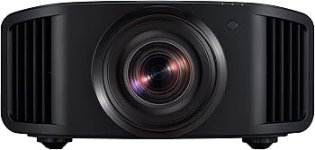The JVC DLA-NZ9 D-ILA laser projector claims to deliver a cinematic experience that rivals even the best commercial theaters. But with a price tag that makes some luxury cars look like a bargain, is it really worth the investment for the average home theater enthusiast? This projector boasts impressive specs like 3000 lumens, native 4K resolution, and 8K e-ShiftX technology, all while promising low-latency gaming and stunning HDR visuals.
However, let’s unpack this further. Is the leap to 8K truly necessary for most viewers, or is it just a marketing ploy to entice those eager to be on the cutting edge? And with features like Frame Adapt HDR and an auto tone mapping function, does this projector really make watching movies and playing games a transformative experience, or are we just buying into the hype?
In this review, we’ll dive deep into the JVC DLA-NZ9’s performance, explore its real-world usability, and ultimately question whether it really delivers on the promise of a high-end home theater experience—or if it’s simply a shiny gadget for tech enthusiasts. Let’s get into it.
I'm considering the JVC DLA-NZ9 D-ILA Laser Home Theater Projector and would love to hear from anyone who has experience with it. The specs sound incredible with 4K and 8K capabilities, and the 3,000 lumens brightness seems perfect for vibrant movie nights and gaming sessions.
How does the picture quality hold up in real-world settings? I'm particularly interested in how the HDR and color accuracy perform—does it really deliver that immersive experience they advertise?
On the sound side, I'm curious if the projector has any built-in audio capabilities that are worth mentioning or if it’s better to invest in a separate sound system for optimal performance.
Also, I’ve read a bit about the system's adaptability features, which sound great for customizing the viewing experience. How intuitive is it to set up? Are there any significant downsides or issues that you've encountered with this model?
Thanks in advance for your insights!
However, let’s unpack this further. Is the leap to 8K truly necessary for most viewers, or is it just a marketing ploy to entice those eager to be on the cutting edge? And with features like Frame Adapt HDR and an auto tone mapping function, does this projector really make watching movies and playing games a transformative experience, or are we just buying into the hype?
In this review, we’ll dive deep into the JVC DLA-NZ9’s performance, explore its real-world usability, and ultimately question whether it really delivers on the promise of a high-end home theater experience—or if it’s simply a shiny gadget for tech enthusiasts. Let’s get into it.
Spec
| Parameter | JVC DLA-NZ9 Home Projector |
|---|---|
Picture | |
Reference Price | $16199.99 |
Recommended Uses | Gaming |
Built-In Media | User Manual, Remote Control, Batteries, Power Cord, 3D Emitter (Optional) |
Highlight | POWERFUL 8K HDR PROJECTOR FOR HI-RES CONTENT: With (3) 0.69-inch native 4K D-ILA devices and a premium 18-element, 16-group 100 mm all-glass lens, the JVC DLA-NZ9 D-ILA home theater projector delivers optical brightness of 3,000 lumens and longevity of 20,000 hours. VIBRANT & DYNAMIC MOVIES & GAMES: Featuring the new 8K/e-shiftX technology with 240 Hz refresh to display 4K content in 8K resolution, 8,192 x 4,320 pixels, (2) HDMI 8K/60p and 4K/120p inputs, and low-latency mode, this projector offers 3D immersive video (glasses sold seperately) and lag-free gaming. Enjoy the latest streaming devices or HDR applications with vibrant images from Apple TV, Roku, Amazon Prime TV and Netflix. HIGH-CONTRAST REALISTIC IMAGING: The latest BLU-Escent Light Source offers depth and dimension to 8K imagery even on larger screens. The new laser dynamic control translates the native contrast ratio of 100,000:1 to a dynamic contrast ratio of Infinity:1 and full fade to a wide color gamut and cinema filter images will be 100% DCI-P3. AUTO TONE MAPPING: The screen projector features Frame Adapt HDR that instantly analyses any HDR10 content frame-by-frame & automatically adjusts to achieve optimal images close to reality. Supports HDR formats like HLG, HDR10, HDR10+ & BT.2020 wide color gamut QUICK AND EASY ADAPTATION: Adjust the Theater Optimizer settings according to the environment using installation mode that includes lens control, pixel adjustment, mask, anamorphic on or off, screen adjust, installation style, keystone, pincushion, and aspect. Control: Control4 SDDP / LAN / RS-232C / IR / 12V Screen Trigger Output / 3D Sync Output |
Throw Distance | 18.52 Feet - 22.75 Feet |
Contrast Ratio | 150,000:1 Native, Infinity:1 Dynamic Contrast Ratio |
Maximum Resolution | 8K (7680 x 4320) |
Native Resolution | 3840 x 2160 |
Brightness | 3000 Lumen |
Display Type | Laser |
Picture Enhancement | 8K upscaling and HDR optimization |
Video Encoding | Multiple standard video encoding formats for 8K and 4K resolutions with HDR |
LightSource Life | 2E+4 Hours |
Controller Type | Button Control |
Control Method | App |
Wattage | 440 watts |
Connectivity Technology | USB, HDMI |
Hardware Connectivity | HDMI |
Compatible Devices | Gaming Consoles |
Other Features | Auto Focus |
How does the picture quality hold up in real-world settings? I'm particularly interested in how the HDR and color accuracy perform—does it really deliver that immersive experience they advertise?
On the sound side, I'm curious if the projector has any built-in audio capabilities that are worth mentioning or if it’s better to invest in a separate sound system for optimal performance.
Also, I’ve read a bit about the system's adaptability features, which sound great for customizing the viewing experience. How intuitive is it to set up? Are there any significant downsides or issues that you've encountered with this model?
Thanks in advance for your insights!




